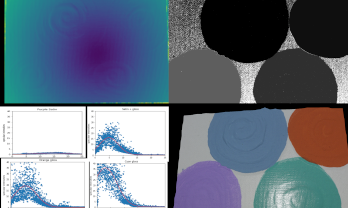References
1GengJ.2011Structured-light 3D surface imaging: a tutorialAdv. Opt. Photon.3128160128–6010.1364/AOP.3.000128
2TranV. L.LinH.-Y.2018A structured light RGB-D camera system for accurate depth measurementInt’l. J. Opt.201810.1155/2018/8659847
3ZhangS.2018High-speed 3D shape measurement with structured light methods: A reviewOpt. Lasers Eng.106119131119–3110.1016/j.optlaseng.2018.02.017
4WardG. J.1992Measuring and modeling anisotropic reflectionProc. 19th Annual Conf. on Computer Graphics and Interactive Techniques (SIGGRAPH ’92)265272265–72Association for Computing MachineryNew York, NY, USA10.1145/142920.134078
5DanaK. J.WangJ.2004Device for convenient measurement of spatially varying bidirectional reflectanceJ. Opt. Soc. Am. A211121–1210.1364/JOSAA.21.000001
6NamG.LeeJ.WuH.GutierrezD.KimM.2016Simultaneous acquisition of microscale reflectance and normalACM Trans. Graph3518510.1145/2980179.2980220
7GhoshA.ChenT.PeersP.WilsonC. A.DebevecP.2009Estimating specular roughness and anisotropy from second order spherical gradient illuminationComput. Graph. Forum28116111701161–7010.1111/j.1467-8659.2009.01493.x
8GardnerA.TchouC.HawkinsT.DebevecP.2003Linear light source reflectometryACM Trans. Graph22749758749–5810.1145/882262.882342
9AittalaM.WeyrichT.LehtinenJ.2013Practical SVBRDF capture in the frequency domainACM Trans. Graph.32110111110–110.1145/2461912.2461978
10FranckenY.CuypersT.MertensT.BekaertP.2009Gloss and normal map acquisition of mesostructures using gray codesProc. 5th Int’l. Symposium on Advances in Visual Computing: Part II (ISVC ’09)788798788–98SpringerBerlin, Heidelberg10.1007/978-3-642-10520-3_75
11WangC.SnavelyN.MarschnerS.2011Estimating dual-scale properties of glossy surfaces from step-edge lightingACM Trans. Graph.301121–1210.1145/2070781.2024206
12FerwerdaJ.2018Lightweight estimation of surface BRDFsJ. Imaging Sci. Technol.6210.2352/J.ImagingSci.Technol.2018.62.5.050407
13AittalaM.WeyrichT.LehtinenJ.2015Two-shot SVBRDF capture for stationary materialsACM Trans. Graph.3411010.1145/2766967
14RiviereJ.PeersP.GhoshA.2016Mobile surface reflectometryComput. Graph. Forum35191202191–20210.1111/cgf.12719
15HuiZ.SunkavalliK.LeeJ.-Y.HadapS.WangJ.SankaranarayananA. C.2017Reflectance capture using univariate sampling of BRDFs2017 IEEE Int’l. Conf. on Computer Vision (ICCV)537253805372–80IEEEPiscataway, NJ10.1109/ICCV.2017.573
16RomeiroF.VasilyevY.ZicklerT.2008Passive reflectometryECCVLNCS 5305859872859–7210.1007/978-3-540-88693-8_63
17DeschaintreV.AittalaM.DurandF.DrettakisG.BousseauA.2018Single-image SVBRDF capture with a rendering-aware deep networkACM Trans. Graph.3712810.1145/3197517.3201378
18MartinR.RoullierA.RouffetR.KaiserA.BoubekeurT.2022MaterIA: single image high-resolution material capture in the wildComput. Graph. Forum41163177163–7710.1111/cgf.14466
19VecchioG.PalazzoS.SpampinatoC.2021SurfaceNet: adversarial SVBRDF estimation from a single image2021 IEEE/CVF Int’l. Conf. on Computer Vision (ICCV)IEEEPiscataway, NJ10.1109/ICCV48922.2021.01260
20BossM.JampaniV.KimK.LenschH. P. A.KautzJ.2020Two-shot spatially-varying BRDF and shape estimation2020 IEEE/CVF Conf. on Computer Vision and Pattern Recognition (CVPR)IEEEPiscataway, NJ10.1109/CVPR42600.2020.00404
21BaekS.JeonD.TongX.KimM.2018Simultaneous acquisition of polarimetric SVBRDF and normalACM Trans. Graph. (TOG)371151–1510.1145/3272127.3275018
22RushmeierH.LockermanY.CartwrightL.PiteraD.2015Experiments with a low-cost system for computer graphics material model acquisitionProc. SPIE939893980610.1117/12.2082895
23PadhyeS.MessingerD.FerwerdaJ.2021A practitioner’s guide to fringe projection profilometryProc. IS&T Archiving 2021566056–60IS&TSpringfield, VA
24BakerM. J.XiJ.ChicharoJ. F.2008Elimination of non-linear luminance effects for digital video projection phase measuring profilometers4th IEEE Int’l. Symposium on Electronic Design, Test and Applications (delta 2008)IEEEPiscataway, NJ10.1109/DELTA.2008.90
25HuangP. S.HuQ. J.ChiangF.2002Double three step phase-shifting algorithmAppl. Opt.41450345094503–910.1364/AO.41.004503
26HerraezM. A.BurtonD. R.LalorM. J.GdeisatM. A.2002Fast two-dimensional phase-unwrapping algorithm based on sorting by reliability following a noncontinuous pathJ. Appl. Opt.41743710.1364/AO.41.007437
27RobertsonM. A.BormanS.StevensonR. L.1999Dynamic range improvement through multiple exposuresProc. 1999 Int’l. Conf. on Image ProcessingVol. 3159163159–63IEEEPiscataway, NJ10.1109/ICIP.1999.817091
28ZhangZ.2000A flexible new technique for camera calibrationIEEE Trans. Pattern Anal. Mach. Intell.22133013341330–410.1109/34.888718
29MorenoD.TaubinG.2012Simple, accurate, and robust projector-camera calibration2012 Second Int’l. Conf. on 3D Imaging, Modeling, Processing, Visualization & Transmission464471464–71IEEEPiscataway, NJ10.1109/3DIMPVT.2012.77
30BurdescuD. D.BrezovanM.GaneaE.StanescuL.2009A new method for segmentation of images represented in a HSV color spaceAdvanced Concepts for Intelligent Vision Systems606617606–17SpringerCham10.1007/978-3-642-04697-1_57
31
32
33

 Find this author on Google Scholar
Find this author on Google Scholar Find this author on PubMed
Find this author on PubMed
 Open access
Open access